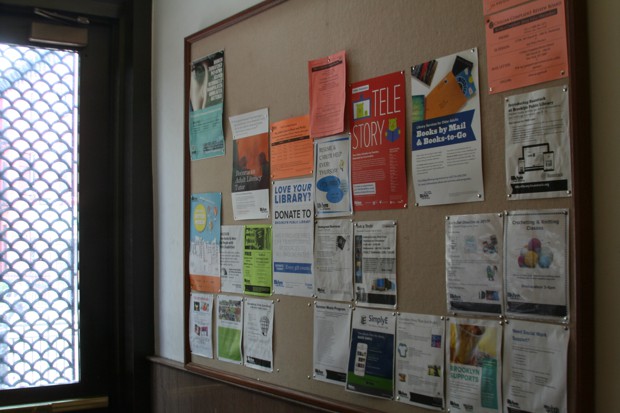Helping Homeless New Yorkers by the Books

With a new resident social worker, the Brooklyn Public Library is pushing staff and patrons toward a culture of inclusivity.
A little after 10 a.m. on a humid Thursday in June, a fan is already whirring in the Bedford Avenue branch of the Brooklyn Public Library. The building has just opened, but already people are pushing through the doors and posting up at computer stations or tables on the mezzanine. Many will stay put all day.
The library, just down the block from a clanging subway station in the Bed-Stuy neighborhood, is a salve for the chafing street noise and the heat. There’s nothing to buy, no time limit, no implication that you’ve overstayed your welcome. The airy, 17,000-square-foot space is a comfortable homeroom for people with nowhere else to be.
And today, there are donuts. Those are a big draw, explains Harold Holloway, as he rearranges coffee stirrers and packets of sugar. Holloway buzzes around a table just off the reference desk, next to a magazine rack holding Latina Style and Highlights.
Holloway is an advocate with the Street to Home program from Breaking Ground, a nonprofit that aims to connect homeless New Yorkers with housing.
As people wander inside, Holloway greets them with a hearty “Hey brother, how you doing?” and waves them over to the table. As they pour a coffee or reach for a sprinkled donut, they can also survey a smattering of handouts: information about where to find a shower, clean pairs of socks and underwear, or a shaving kit; addresses of drop-in shelters that are open 24 hours a day.
Dabbing up spilled coffee, a woman in her late 50s describes spending the last year in a shelter in midtown Manhattan. She’s looking for a new apartment, but the process is complicated. “It’s not like years ago when you could see a posting in a window,” she tells me. Last time she stopped by the library, she says, Holloway helped her create an email address.
Whether or not they’re girded for it, neighborhood branches have become social services hubs. In Brooklyn, it’s a challenge that library staff are trying to meet head-on, right between the stacks.
***
By sheer volume, New York City’s homelessness crisis has compounded over the past few decades. In April of this year, there were 61,277 people in the city’s shelter system, a slight decline from the record 62,840 counted in November 2016. Durations of shelter stays vary by demographic—single adults tend to have the most abbreviated residency, while families with children under 18 linger longer—but across the board, the average stay exceeds 365 days. Among this vulnerable population, there are profound disparities across racial lines: 58 percent of the residents in the city’s shelters are African American, and 31 percent are Latino; just 7 percent are white.
Homelessness springs from a constellation of factors. On the housing front, there’s the shrinking stock of affordable units, and vanishing protections for rent control. Families looking for low-rent units have a remarkably narrow field to reap. One recent survey from the city’s Department of Housing and Preservation estimated that among the units asking less than $800 per month, the vacancy rate was just 1.8 percent.
Then there are questions about cash flow and a safety net to soften a potential setback. Volatile income streams and insufficient emergency savings dog 67 percent of the residents who live near the Bedford library, according to a 2015 Urban Institute study.
While the city has poured sizable investments into reducing homelessness across the five boroughs, the level of need remains staggering. The de Blasio administration is rolling out a new plan to counter the tide. The strategy aims to reduce the number of people in the shelter system by 2,500 over the next five years. To do so, it proposes dismantling cluster apartments—which consolidate homeless New Yorkers in privately owned buildings—and relocating residents from hotel shelters by 2021. The administration’s plan calls for replacing those facilities with 90 new shelters and expanding 30 existing ones. The timeline projects 20 new shelters in 2017 and another 20 next year.

Comments
Post a Comment